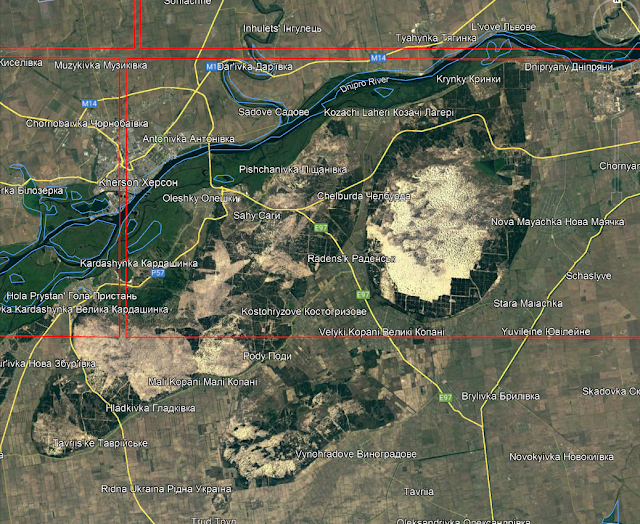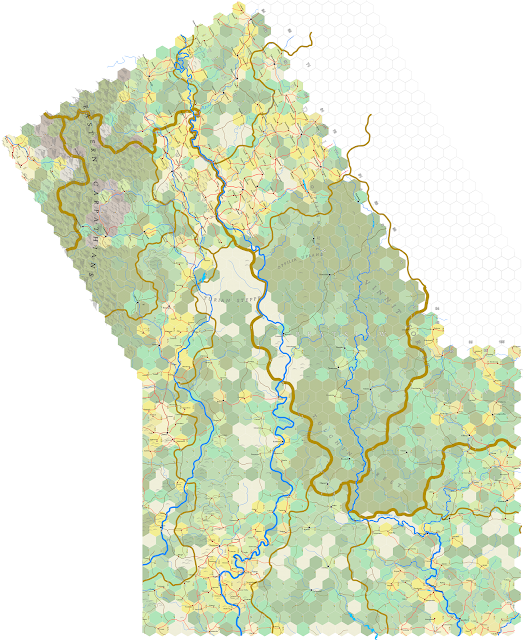I was getting a little tired with how slow I was moving through central Ukraine, so I took some time on a slow Sunday, yesterday, and did six sections. We have a lot to talk about.
Starting with, first, this part of Lakany, northeast of Vozakan.
This links up the Southern Bug. Note the elevation numbers in the corners; the "6" near Privolson is that many feet above sea level, so we can see how close we are to the Black Sea. The "738" ft. figure for Lakany is a mystery to me, since I couldn't find anything on GoogleEarth to suggest that elevation, meaning that my source material was in error. Doesn't matter, really. I've already committed myself.
All through this area, the rivers are about 200 ft. below the plateau stretching towards the sea ... not enough for a hill symbol, but worth noting. The infrastructures are thinning out, letting some steppe-hexes through, but not many. As we progress east, however, the roads also thin out, with the occasional centre becoming more isolated. Mykil is 18 miles from Abrono; that's a long journey given the density of places we found in Vassia.
Here's the next two sections to the east:
This stretches east to the big city of Krivoi. However, when you read "Krivoi" you should be thinking "Pittsburgh."
There are certain places in the world where iron ore and high grade coal lay side-by-side in a way that makes it brilliant for making steel. The Ruhr is one such place; Silesia is another. Others include Pittsburgh, Shenyang and two places in Siberian called Kuznetsk and Minusinsk. Way, way out in Siberia. Where it gets brutally cold.
Forgive me while I get political a moment. The Ukraine has two such areas, about two hundred miles apart. The bigger one is the Donetsk, which the Russians have occupied since 2014. There's a great amount of fighting going on over this region, as it was the old Soviet Union's most valuable geographical asset ... which it lost when the Ukraine became independent. The other coal-iron area is called the Kryvbas, though the coal part is lacking while the iron very much is not. This is what the Russians want in this war; they want to stabilise the Donbas and they want to take and hold Krovoi; this summer they failed spectacularly in doing both. But here's something to think about: the west, especially the Germans and the French, are chest deep in the Kryvbas' development; the Kryvbas is one reason Europe wants the Ukraine in the E.U., and if you want to understand why American and European weapons are expensively being sent to the Ukraine, it's here. If the Kryvbas fell into Russian hands, the price of steel would shoot up, it would sustain the Russian's future war machine and it would be a disaster for many companies who can't afford to lose the place as an asset.
But, as I said, Russia choked and didn't get there. How come the press hasn't mentioned any of this? Well, I'll point out the press said jack shit about Cominco's interests in Kosovo in the 1990s, too. There are very definite muzzling aspects about wars carried out for the benefit of huge multinational conglomerates ... mostly because they own the press. But go look for it. The information is out there. It's just not mainstream, and most of it's written in a way that if you don't know how important Krivoi is, you won't understand why the reporter's discussing it.
Oh, nearly forgot. Krivoi is Ukrainian President's Volodymyr Zelensky's home town. He knows exactly how valuable it is.
Mapping Krivoi, then. I had a surprise to discover there was a big inconvenient lake where I'd previously put the road south of Krystofos above, so some changes needed to be made:
I thought I'd give a wide scale image of the area; sorry if this makes it difficult to read the post and look at the map at the same time.
We haven't seen Krivassa yet. This is again a made-up province for Little Tartary. It corresponds to a "raion," or political district that's part of the Dnepropetrovsk Oblask; the city of Dnepropetrovsk (not on the map) has been renamed "Dnipro" since 2016. Which is easier to say. It's an eastern bulwark against the Zaporozhians, controlling the west bank of the Dneiper while the latter controls the east bank. Krivoi isn't a market town, just a big manufacturing burgh in my game world; the outlet market is Kopol, shown on the bottom right of the map with the name cut off.

One last thing about Krivoi. A look at GoogleEarth around the city is fascinating; the city is surrounding by open pit mines, many of which have been closed. The image shown shows three big ex-pits, with the lake appearing on the map for scale. I've set the mouse so that it gives the elevation on the nearest, biggest pit, shown in the bottom right of the screen, -925 ft. The level of the land is 190 ft. above sea level, so this makes the pit nearly 1,100 ft. deep. The other two are slightly less deep, -566 and -475 ft. The big pit is 2 miles from edge to edge. Wikipedia shows them filled with water.
Oh, also, these maps are from 1985. I use the oldest maps of GoogleEarth I can find. I leave it to the player to look into what this area looks like today.
Obviously, none of these exist in the 17th century, nor the hills surrounding Krivoi made of the material. And though it's understood that the discovery of iron in the area began in the 19th century, I'm going to let magic detect the iron before that, so that in my game world Krivoi is a pre-industrial digger of iron ore, just the same.
Moving on, then ...
We're back in Lakany, skipping west and one line south again. Here's another gap in the Southern Bug that needs connecting. That river that flows west of Privolson turns out not to be there; it does flow through Privolson, but then it turns south.
There, all nice and neat. All the rivers drift to the south, towards the Sea. This is the very bottom of the Kiyev sheet, so I'll be moving south onto the next sheet with tomorrow's post (and copying the top two hexes of that map onto the bottom two of this one). The Kiyev sheet felt like it took forever to cross.
Two sections left. Here's the rough:
That's the big Dneiper river on the bottom right, which we'll be mapping soon. The four hexes here went fairly quickly, with their little bits of infrastructure. The Inhul and Inhulets rivers dominate the landscape.
That's all of it. Nice to see some lakes for a change. This is as far east as the map has ever been, and it's going to to out farther. But I'll talk about that tomorrow.
%20Karkin%20Gulf.png)
%20Karkin%20done.png)
%20Kherson,%20west%20of%20Or-Kapi.png)
%20west%20of%20Or-Kapi%20done.png)
%20Kherson,%20northeast%20of%20Or-Kapi.png)
%20ne%20of%20Or-Kapi%20done.png)
%20Kherson,%20north%20of%20Genichan.png)
%20north%20of%20Genichan%20done.png)

%20Kherson%20sanjak,%20south%20of%20Kherson.png)
%20south%20of%20Kherson%20done.png)
%20Kherson,%20around%20Agayman.png)
%20around%20Agayman%20done.png)
%20Kherson%20Sanjak,%20southwest%20of%20Kherson.png)
%20southwest%20of%20Kherson%20done.png)


%20south%20of%20Berishan%20done.png)
%20Kherson,%20east%20of%20Kherson.png)


%20east%20of%20Kherson%20done.png)
%20Kherson,%20north%20of%20Agayman.png)
%20north%20of%20Agayman%20done.png)
%20Ozi-Lakany,%20south%20of%20Lakanadar.png)
%20south%20of%20Lakanadar%20done.png)
%20Kherson,%20around%20Berishan.png)
%20around%20Berishan%20done.png)


%20Lakany,%20around%20Lakanadar.png)
%20around%20Lakanadar%20done.png)
%20Lakany%20&%20Kherson,%20north%20of%20Barishan.png)
%20north%20of%20Barishan.png)
%20Kherson,%20west%20of%20Tikha.png)
%20west%20of%20Tikha%20done.png)

%20Kherson,%20around%20Tikha.png)
%20around%20Tikha%20done.png)




%20Lakany.png)
%20East%20of%20Ipsaklava%20done.png)








